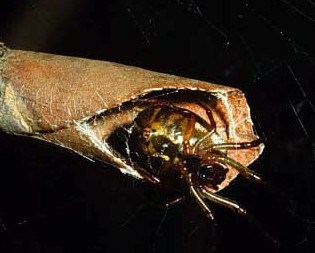The full size of a Leaf Curling Spider is the size of a 50 cent piece. The size of one leg is like a pin. They have a brown body and a creamy yellow abdomen and pale markings. The scientific name for the Leaf Curling Spider is Phonognatha graeffei. Normally the female’s size is about 8mm and […]
Mouse Spider
The common name of the Mouse Spider is derived from the mistaken belief that this spider excavates a deep mouse-like burrow. Mouse Spiders belong to the family Actinopodidae, which consists of one genus – Missulena – and eight described species which include the Trapdoor spider family. The Mouse Spider is a member of the Trapdoor […]
Candy Stripe Spider
Family: TheridiidaeScientific name: Enoplognatha ovataCommon name: Candy Stripe or Polymorphic spider This colourful spider often builds webs on plants. Its colours can vary greatly. Yellow, white, green. Notice the significant black dots on the side of the abdomen. The name Candy Stripe comes from the specimens with the red stripes. Note the spider on the purple […]
Pirate Spider
The family Mimetidae, commonly called pirate spiders, are spiders which typically feed on other spiders. The family Mimetidae contains roughly 200 species divided among 12 genera, of which Mimetus and Ero are the most common. Mimetids are usually yellow and brown and are usually 3 to 7 mm long. Mimetids can be recognized by the rows of spine-like hairs on their long front legs; the rows […]
Wandering Spiders
Wandering Spiders are large, with bodies reaching up to 2 inches (5 centimeters) and leg spans reaching about 6 inches (15 cm). The species vary in color, though all are hairy, mostly brown and may have a black spot on their bellies. These arachnids “are called wandering spiders because they do not build webs but wander […]
Zoropsis Spinimana
Zoropsis spinimana is a spider species, belonging to the family Zoropsidae. It is distributed widely in the Mediterranean, but reaches into Russia, and was introduced to the United States, primarily in the San Francisco Bay Area. Males of the spider species Zoropsis spinimana reach a length of about 10–12 millimetres (0.39–0.47 in), while females are 15–18 millimetres (0.59–0.71 in) long. […]
Lynx Spider
Lynx spiders get their name from the way that they sometimes pounce on their prey in a catlike fashion. These spiders spend their time hunting for insects in bushes and low plants. They are fast runners, but can occasionally be seen lying in wait for prey beside flowers. They build no web for prey capture, […]
Black House Spider
Black and Grey House Spiders are widely distributed in southern and eastern Australia and are also found in the United States. Their webs form untidy, lacy silk sheets with funnel-like entrances. Black House Spiders are found on tree trunks, logs, rock walls and buildings (in window frames, wall crevices, etc). Badumna longinquus may be found in […]
Hackle Mesh Weaver
Hacklemesh Weaver Spiders (or Hackledmesh Weaver), Callobius Bennetti, belong to the Callobius family which is a spider genus in the family Amaurobiidae. Amaurobiidae is a family of spiders also known as “tangled nest spiders”, “night spiders” or “hacklemesh weavers”. These cribellate spiders of medium size look similar to the related Agelenidae, (funnel weavers) but have shorter legs and much smaller spinnerets. They share many […]
Neoscona Semarak
Neoscona Sp. are hairy field orb weaving spiders with a round abdomen which overhangs the carapace. The genus Neoscona is similar to Caerostris being nocturnal and cryptically coloured. The legs are equipped with numerous spines. During the day this spider takes refuge amongst leaves and in or under bark. Neoscona species are very variable in colour. This is the spider responsible for the […]










